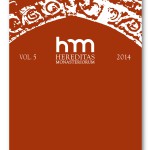Kościół św. św. Piotra i Pawła Apostołów oraz inne zabudowania jezuickie i benedyktyńskie w Pułtusku (inwentarze 1781–1882 i dokumentacja foto)
The Church of SS. Apostles Peter and Paul and other Jesuit and Benedictine buildings in Pułtusk (inventories,1781–1882 and photographic documentation)
Author(s): Krzysztof WiśniewskiSubject(s): History
Published by: Laboratoire de Recherches sur l'Histoire des Congregations et Ordres Religieux (LARHCOR)
Keywords: Jesuits; Benedictines; Pułtusk; inventories; buildings; dissolution
Summary/Abstract: In the first part of the article the author examines the history of Jesuit and Benedictine buildings in Pułtusk from their construction till the present. The Church of SS. Apostles Peter and Paul was built by the Jesuits in 1688–1702, though work inside the church went on until 1718, when the church was consecrated. The furnishing of the church continued in 1720–1764. The Jesuit College was housed in buildings erected in the 1550s and 1560s. After the suppression of the Society in 1773 the church and the school were taken over by the Commission of National Education and then, in 1781, by the Benedictines, who had moved here from Płock. In 1803–1806 and 1816–1819 the Benedictines built a new monastery and school, and in 1827–1828 they carried out a thorough renovation of the church, which was considered at that time to be one of the most beautiful churches in the Diocese of Płock. After the dissolution of the Benedictine monastery in 1864, the church was given to the (collegiate) Parish of St. Matthew. In 1875 it was ravaged by a huge fire, in which most of the furnishings were burnt. The Second World War saw a destruction of the towers in the main facade. Since 2011 the Church of SS. Peter and Paul has been the parish church of St. John Paul II’s Parish. In the second part of the article the author presents the circumstances of the compilation of the inventories published in part three. The first inventory (no. 1) was compiled in 1781, when the former Jesuit church and monastery were being taken over by the Benedictines. A comparison between its entries and the inventory taken in 1775 during Bishop Krzysztof Szembek’s inspection reveals many missing items of movable property, especially those made of gold or silver, most of which must have enriched the treasuries of the Płock cathedral and the Pułtusk collegiate church. Another inventory taking came in late 1864 and early 1865 (nos 2–5) in connection with the dissolution of the Pułtusk monastery. The 1869 inventory (no. 6) was compiled when the monastery building was being taken over by a school. The last inventory (no. 7) was taken in 1882. It shows the Benedictines’ movable and immovable property during the dissolution and the scale of the damage wreaked by the 1875 fire. Only few items survived it.
Journal: Hereditas Monasteriorum
- Issue Year: 2014
- Issue No: 5
- Page Range: 107-161
- Page Count: 55

